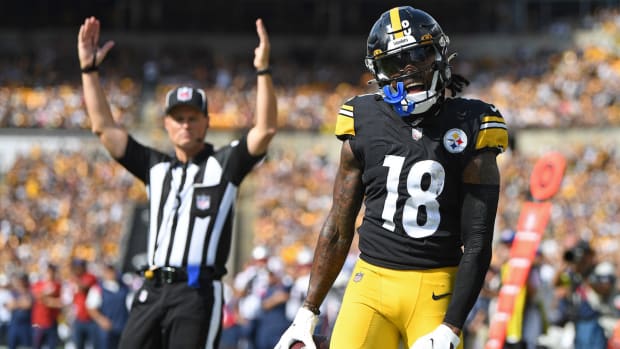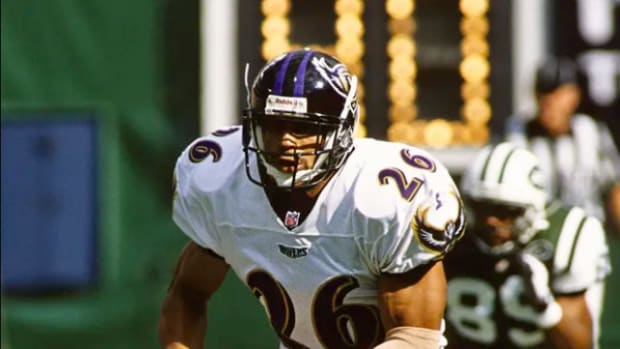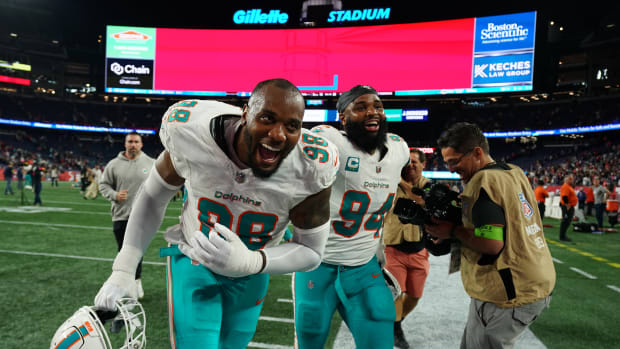Fantasy Football: David Johnson, Kenyan Drake Among Early 2019 Bounceback Candidates
June has arrived and with it another year of fantasy football draft prep. We’ll have you covered all summer as you get ready for your drafts and auctions, running forward and backward across the entire fantasy football landscape. To start, we’ve set the scene with sleepers, busts, breakouts and now finally bouncebacks.
Bounceback players are the easiest to define. These are players who underperformed expectations last season, but will rebound this year. Underperforming expectations is not a synonym for playing poorly. Some of our 2019 bounceback candidates had fine 2018 seasons, but not anywhere near what was expected of them. All, however, will surge back to their pre-downturn levels this season. Injured players generally weren’t considered, but one player who missed nearly all of last season due to an injury is included because his value is simply too good to ignore. Value here is relative to average draft position in early 2019 drafts.
ADP data is courtesy of Fantasy Football Calculator.
David Johnson, RB, Cardinals (ADP: 5.8)
Johnson is one of those players who had a solid 2018 season that came up well short of expectations. He was the top overall pick in some leagues and a consensus top-three pick across the industry, but ended the year as the ninth-ranked running back and 19th-ranked flex player (running backs, receivers and tight ends) in half-PPR leagues. That simply doesn’t cut it for a player selected in the top three.
Still, it was a minor miracle that Johnson played as well as he did last season. The Cardinals offense was a mess all year, ranking last in the league in scoring and total offense, scoring 20 fewer points and racking up 800 fewer yards than the teams ranked 31st in those respective categories. It should be impossible for a running back stuck in that environment to be a fantasy RB1, and yet Johnson pulled it off, no matter the scoring format. He ran the ball 258 times for 940 yards and seven scores, and caught 50 passes for 446 yards and three more touchdowns. Johnson was responsible for 35.8% of Arizona’s scrimmage yards and 41.7% of its touchdowns, and while there’s obviously some value in being the best weapon on an offense, no one wants to be at the center of ineptitude. Todd Gurley significantly out-produced Johnson, totaling 1,831 yards from scrimmage and 21 touchdowns, but was responsible for 27.1% of the Rams’ yards and 38.2% of their touchdowns. Everyone needs a little help from their friends. Johnson should finally get some this year.
Gone from Arizona are Steve Wilks, Mike McCoy (he was fired halfway through last season) and Josh Rosen. In are Kliff Kingsbury and Kyler Murray, bringing an entirely new offensive look and philosophy to the team. It’s impossible to overstate the life these two can breathe into Johnson. Murray has the skill set to be an instant star in the modern NFL, and his rushing ability should open up lanes for Johnson. Kingsbury’s offense will spread it out and move quickly, an ideal construct for a do-it-all running back who can break big plays on the ground and through the air. It isn’t hard to look back at the Johnson who piled up 1,239 rushing yards, 80 receptions, 879 receiving yards and 20 touchdowns under Bruce Arians in 2016, and see echoes in the player and offense we may get in 2019. Johnson slogged his way to an RB1 season last year. He’ll sprint his way to one this year.
Kenyan Drake, RB, Dolphins (ADP: 48.5)
Whatever Adam Gase had against Drake will be lost to history with the coach now Le’Veon Bell’s problem in New York. Despite being easily the best back in Miami last year, Drake took a back seat to Frank Gore, getting just 120 carries to the veteran’s 156. Drake had double-digit carries in five games, and just one of those was after October. He had fewer than 10 touches six times, and exactly 10 in another three games. Gase made him into a secondary option even though he was clearly the most talented offensive player on the team.
Those playing-time concerns left town with Gase in the offseason. The Dolphins this year hired former New England defensive coordinator Brian Flores as their head coach, and he in turn brought with him former Patriots quarterbacks coach Chad O’Shea to run the offense. Gore is gone, too, heading to Buffalo, leaving Drake atop a depth chart that includes Kalen Ballage and seventh-round pick Myles Gaskin as his competition. In other words, Drake should easily lead this backfield, and the new regime, which already has its sights set on 2020 and beyond, should be cultivating whatever true talent it has on the roster. Drake is, without question, one of the few players already on the team who could be a major contributor to the next playoff contender in Miami.
Remember, it’s not as though Gase should have needed to see something special from Drake behind the closed doors of a team practice to hand him the backfield reins. It was on full public display at the end of 2017. Drake was a star over the final five games of that season, running for 444 yards on 91 carries, totaling 150 receiving yards on 17 catches, and scoring two touchdowns. Those numbers translate to a 16-game pace of 1,421 rushing yards, 54 receptions, 480 receiving yards, and six touchdowns. In fantasy terms, Drake’s five-game starring run in 2017 equated to a full-season pace for 253.1 points in half-PPR leagues, which would have been more than all but five backs had last year. Drake has that sort of ceiling in him, and he finally has a coaching staff that is desirous of investing in his talent.
Allen Robinson, WR, Bears (ADP: 76.5)
Robinson’s first season in Chicago was a bit of a mixed bag. He was everything the 2018 iteration of the Bears needed, a legitimate downfield weapon who made Mitchell Trubisky better and forced defenses to plan for a game-changing receiver. It didn’t, however, restore him to fantasy greatness. Robinson caught 55 passes for 754 yards and four touchdowns, ending the season ranked 40th among receivers in total points in half-PPR leagues, and 34th in points per game. He was a season-long WR3/4 without much of a ceiling, and that just doesn’t move the needle very much in fantasy leagues.
This season, however, should be different. The Bears started putting an admirable offensive infrastructure in place last season, and the divergence from the John Fox years was immediately noticeable. Transitioning from a stone-age offense that was among the worst in football to a high-powered unit built for the modern game cannot happen overnight, though, especially with a quarterback who is still in his NFL infancy. Trubisky was a second-year quarterback last season, but it was essentially his rookie year considering the offense he played in under Fox and former Chicago (now Jets) offensive coordinator Dowell Loggains in 2017. Matt Nagy was an architect of the Chiefs’ 2017 offense that ranked sixth in scoring, fifth in yards and third in yards per play, and he looks like one of the game’s brightest young offensive minds, but he was still just a first-year head coach in 2018, learning the ropes of how to manage an entire team and coaching staff rather than just players and position coaches on one side of the ball. The Bears made strides last year, but there was likely always a limit to how much they could improve in one season. That, in turn, curbed what Robinson could do, especially from a fantasy perspective.
The good news for Robinson is 2019 is that the foundation the team created last year could serve as a launching pad. The team didn’t make any major moves at receiver or tight end, meaning Robinson remains the most dangerous pass-catcher on the team by leaps and bounds. If Trubisky at the helm, Nagy on the sidelines, and the offense as a whole takes a step forward this year, Robinson will not only be along for the ride, but will be one of the key players taking the team to a new level. If you believe in the Bears, you should see Robinson as a top-20 receiver.
Delanie Walker, TE, Titans (ADP: 125)
Walker missed the final 15 games of last season after breaking his ankle in Week 1. Typically, we avoid injury-caused bounceback cases. If Walker bounces back in 2019, it won’t be thanks to better coaching (like Johnson and Drake) or maturation of his offense (like Robinson). It will be because he stays healthy, and every single player in every single sport needs health to succeed. Of course Walker is going to bounce back this year. There’s nowhere else for him to go after last season.
However, the fantasy community is sleeping on him so aggressively that his bounceback goes beyond just staying healthy. Walker is the 12th tight end off the board in a typical draft early in the summer, sandwiched between Trey Burton (another strong bounceback candidate, just for the record) and T.J. Hockenson. That’s essentially his floor in a healthy season. In essence, early fantasy drafters are saying that they expect Walker to stay healthy and hit the bottom of his realistic range of outcomes. That is selling the Tennessee tight end woefully short.
After spending the first seven years of his career as a bit player in San Francisco, Walker signed with the Titans in advance of the 2013 season. The team made him into a key player in the offense, and he immediately flourished in the role. From 2013 through 2017, he averaged 71 receptions, 108 targets, 831 yards and 5.2 touchdowns per year. Those numbers come out to 149.9 fantasy points per season in half-PPR leagues. Since 2013, that output has never been worse than the overall TE9, and has been good for an average of TE7.
Walker has been even better in the three full seasons he has played with Marcus Mariota, averaging 78 catches on 115 targets for 898 yards and 5.3 touchdowns per year. That translates to 160.5 fantasy points per season. Walker is in his age-35 season and coming off a gruesome ankle injury, but he has been one of the most durable players of the last decade, playing at least 14 games every season from 2007 through 2017. The Titans did add A.J. Brown in the draft and Adam Humphries in free agency, but a healthy Walker should be, at worst, the second-most targeted receiver in the offense. He’s at near-zero risk of falling out of the TE1 class while carrying an easy top-seven ceiling at the position.
Andy Dalton, QB, Bengals (ADP: N/A)
It was an ugly year in Cincinnati last season, with the Bengals going 6-10 and finishing 17th in points scored and 26th in total offense, bringing an end to the Marvin Lewis era. Take a look back at Dalton’s numbers, and it appears he performed in lockstep with the rest of his teammates. He threw for 2,566 yards, 7.03 yards per attempt and 21 touchdowns against 11 interceptions, missing the final five games of the season due to a thumb injury. Look a little closer, though, and the truth of Dalton’s season emerges.
Through 12 weeks, Dalton was the No. 16 quarterback in fantasy leagues, putting up 16.86 points per game. That doesn’t jump off the page, but it certainly tells the story of a competent, stream-worthy quarterback. Dalton scored more points per game than Nick Mullens, Jimmy Garoppolo, Nick Foles, Sam Darnold, Derek Carr, Matthew Stafford and Marcus Mariota. That may not be a world-beating group, but all were at least in the stream discussion at the end of the season.
The story of Dalton’s 2018 season gets even better. He played his final three games without A.J. Green, who missed seven games because of foot and toe injuries. In eight games with Green healthy, Dalton completed 63.4% of his passes for 2,102 yards, 7.2 YPA and 17 touchdowns against eight interceptions, averaging 18.5 points per game. At that point of the season, Dalton ranked 14th among quarterbacks, right between Tom Brady and Russell Wilson. He was on pace for 296.4 fantasy points, which would’ve landed him 10th, looking up at Drew Brees and down at Cam Newton. In the three games he played without Green, he completed 56.2% of his passes for 464 yards, 6.36 YPA, four touchdowns and three picks.
Dalton goes into this season with a new head coach, former Rams quarterbacks coach Zac Taylor, marking the first time in his career that he’ll have an offensive mind running the entire show. Not only is Green fully recovered from last year’s injuries, but Tyler Boyd also broke out last season. Boyd had 76 catches for 1,028 yards and seven touchdowns last year, proving himself, at worst, a true No. 2 receiver and, at best, a No. 1a to Green’s No. 1. Dalton may not be a quarterback fantasy owners trust every single week, but he’ll be a streamer and brings to the table a QB1 ceiling. In superflex and two-quarterback leagues, he’ll be an easy weekly starter.




































